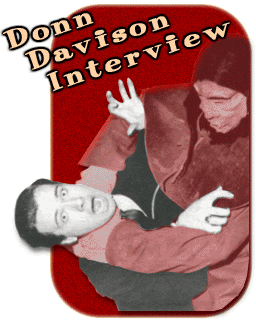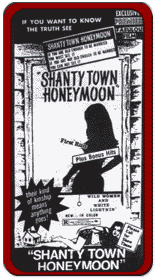 George and I met exploitation master Donn Davison at a Chiller Theater convention in New Jersey about three years ago. He was sharing a table with fellow spook show magician Jim Ridenour. The soft-spoken Davison was indeed a true southern gentleman, treating me like a fellow showman rather than a fan. I spent most of the day speaking with him and I left him a copy of The Journal. Several weeks later, I received a personal phone call from him, telling me how much he liked our publication. I, in turn, asked him if he wouldn't mind granting us an interview. He was more than honored, and a mail correspondence was launched. It took a while, but it was well worth the wait.
George and I met exploitation master Donn Davison at a Chiller Theater convention in New Jersey about three years ago. He was sharing a table with fellow spook show magician Jim Ridenour. The soft-spoken Davison was indeed a true southern gentleman, treating me like a fellow showman rather than a fan. I spent most of the day speaking with him and I left him a copy of The Journal. Several weeks later, I received a personal phone call from him, telling me how much he liked our publication. I, in turn, asked him if he wouldn't mind granting us an interview. He was more than honored, and a mail correspondence was launched. It took a while, but it was well worth the wait.
I want to add that through the correspondence, Davison took the time to help me grow in a more professional and responsible manner. Thanks so much, Donn. Now please, folks, read on ...
Keith Crocker, 1996
EJ: Tell us a little about your youth ...
Donn Davison: I was an amateur magician. I did magic shows in school, the Kawanis Club and places that usually sold tickets. Finally, I got a job doing tricks for the Duncan Yo-Yo company, and I was a yo-yo champion, and a spinning top chanpion as well. This lasted a couple of years. During this time, I learned about the spook shows, and so I launched two very successful ones.
So with your theatrical backgound, where did cinema come in?
Lee Jones and I got together and made a film called Moonshiner's Woman, filmed in thrilling black and white. It's funny though, after I had made my first color film, I recall talking to a film buyer in Dallas, and my youthful exuberance really began to show through as I carried on about the color, and he just said, "Ah, c'mon now Donn, color has been around for a long time." (laughs)
I also did Shanty Town Honeymoon and Obscenity, which later became The Affair. We did The Secret Miracle of Birth, The New Wages of Sin, and McCullough's Mountain, which took advantage of the Bigfoot fad.
Tell us about Film Ventures.
Ed Montoro was a barefoot, headband wearing hippie who had a one room office where he'd smoke pot and screw his secretary on the floor; she practiced that kind of free lifestle (much to the regret of his wife). I met him when I had four reels of Obscenity, Obscenity done. By the way, Pat Patterson was the assistant director on this film. He also built the sets, did special effects, a real jack-of-all-trades. Anyway, Ed had only one picture out at the time, a skin flick called Getting Into Heaven. Ed sort of looked at me as an inspiration because I wore a suit jacket and tie: he thought I really had myself together. And so it was only a short time later that he moved up to a bigger office, cut the hair and moustache, and donned a suit and tie.
What was your first big hit for Film Ventures?
A movie called Boot Hill, which was a sequel to the "Trinity" films (Trinity Is Still My Name), which Joe Levine didn't end up picking up. We bought the rights for $40, 000 and spent just as much on the publicity materials. We did great with that picture; we made our first $40, 000 back in two weeks.
Ed loved to pick up Italian films, mainly because they were cheap. They were also long and boring, and you could cut twenty minutes or so from the print, thus saving print costs. I titled one of them Sundance Cassidy and the Butch Kid, and my catch line was, "Don't confuse them with the other guys!" But dammit, the public confused them with the other guys anyway because we ended up playing for weeks in Denver (laughs).
We'd put names on a film, billing someone as John Wain. You'd be surprised how many of our patrons couldn't spell.
How much did you pay to acquire Beyond The Door?
$100, 000, they never knew how much we were going to make on it. It took in $9 million for us. It was the only imitator of The Exorcist out at that time.
 Did you have any trouble with Warner Brothers?
Did you have any trouble with Warner Brothers?
Plenty! I had an office in Manhattan and I sent out researchers to study exorcism documents that went back to the 14th and 15th centuries, detailing the levitation, the vomitting, etc. I showed that Warner Borhters had no rights to the scenes depicted in The Exorcist. We won, but it was a pain in the ass.
What came next?
Grizzly. The shoot was a pain in the ass. There comes a time when making these films isn't fun anymore. Arguing with production people and crew members, union interference, you name it. It's just one of those things where you breathe a huge sigh of relief when you've got the film in the can.
Ed produced Grizzly and I in turn was producing Secrets of the Gods, and we released both at the same time. We did Day of the Animals, which didn't exactly set the world on fire. Ed and I sort of parted company after that. You see, he developed the Russian menatlity of "what's mine is mine, and what's yours is mine," so that sort of split things up. Ed was brilliant, however. He was creative and clever. He was always a mobster wannabe, he carried a gun. He was from Cleveland. I think he pulled a lot of petty hustles over there. He was like Frank Sinatra; he fancied himself a gangster.
Tell us about director William Girdler.
I knew Bill Girdler from his Studio One Productions that he had down in Kentucky. I did some post-production for Shanty Town Honeymoon at Studio One, and it was Lee Jones who had sent me there. It turned out that Girdler had the script for Grizzly, and Lee suggested that we get involved in it.
Any involvement with Three on a Meathook?
Personally, I thought that it wasn't a bad film. I know Pat Patterson had topped himself with the gore that he had done. It was the best gore that I had ever seen for a low budget picture. Of course, it was so good that it had to be removed, about ten minutes' worth. This was a shame because Patterson worked about 17 hours a day on it.
What are your feelings about the movie going experience these days?
Well, all my childhood was spent in movie theaters. It was a real experience to go to the movies, you dressed up and all; it was a night out. You got what you paid for, as opposed to the rip-off ticket prices these days, the three cents worth of popcorn they charge five bucks for. When I reached my teenage years and found out about driveins, well, that was great, too. That's where I saw all the exploitation that I would later end up making.The theater experience has been ruined. The multiplex thing stinks. I don't go to the movies anymore, I just wait until the films come out on video.
Note: This is only a small portion of the Donn Davison interview. To read the full article, pick up a copy of The Exploitation Journal, Vol. 2 #5. Price: $5.

